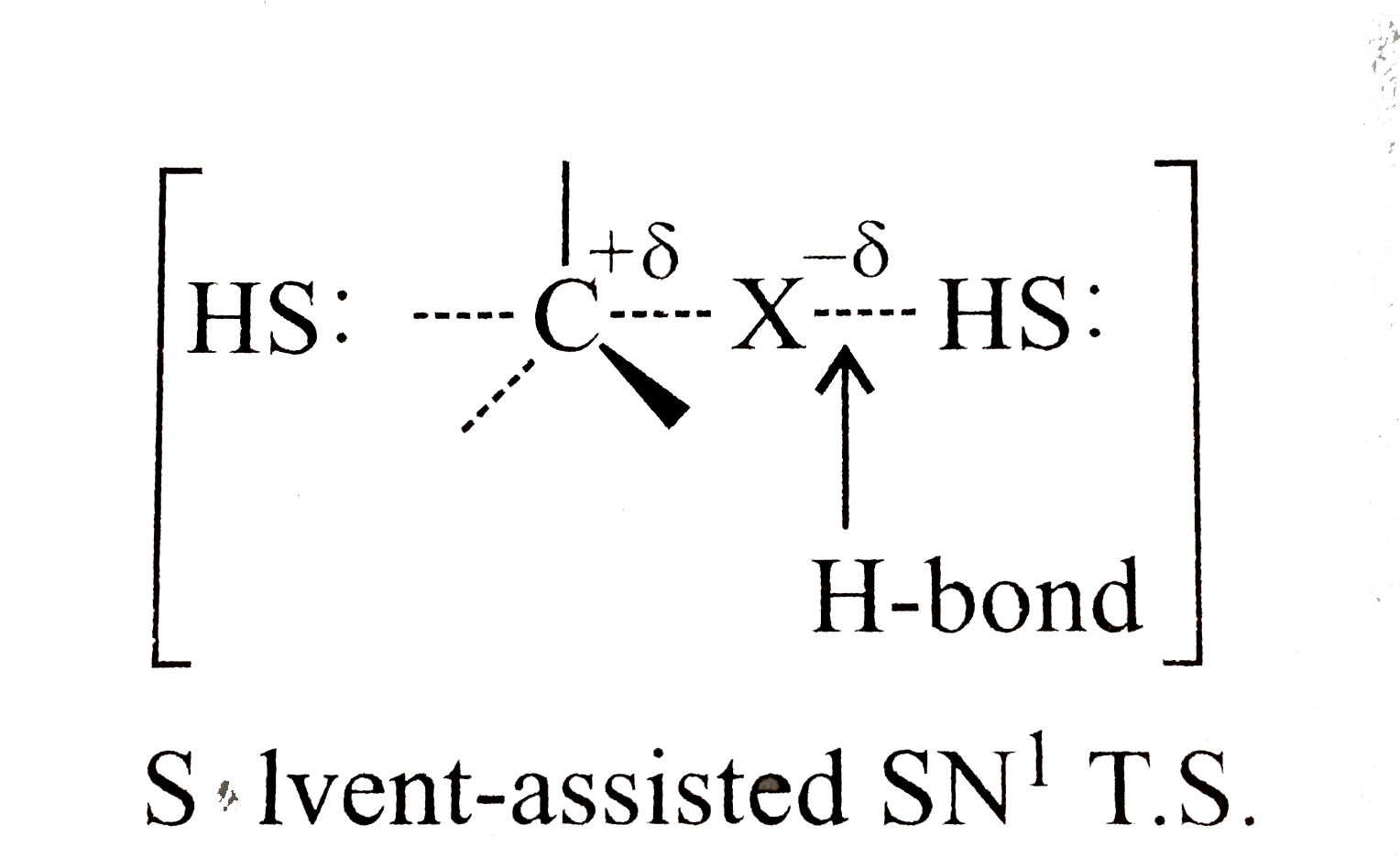(a) Explain how the sterochemistry of SN1 and SN2 differs.
(b) Explain the formation of 60% inverted and 40% racemic product from a typical SN1 reaction.
(c) Account for the following in terms of the rate of solvent in the above problem.
(i) The reaction is first order.
(ii) Under what conditions the rate expression is more than first order ?
(iii) What is the order and molecularity ?
Video Solution
Text Solution
(a) SN2 gives complete inversion of the configuration of the attacked C. If a free R+ were to form in the SN1 reaction, it would be achiral because it would possess a plane of symmetry incorporating its three σ -bonds Its p atomic orbital could be attacked equally well at either of its faces, giving a completely racemic product.
(b) The actual mechanism does not involve a free R⊕ As X leaves and the bond angles open up from 109∘ to 120∘, there is room for the solvent molecule (HS : Polar protic solvent) to approach from the rear. The anion is also solvated by H-bonding as it leaves R

This T.S passes onto a di-solvated intimate ion-pair intermediate :
(HS....R+XӨ...HS:)
If the solvation bond to C get stronger and XӨ leaves completely, an inverted product is obtained.
If H-bond is stronger, it will remove XӨ and hence R+ is formed which gives racemic product.
(c) (i) Althrough the solvent molecules are present in the rate determing T.S., they to not appear in rate expression. In such cases, the reaction in pseudo first order. This shows that solvent molecules intervence in the rate determing T.S.
(ii) When an inert solvent (e.g., benzene) is used with a small amount of nucleophilic protic solvent (MeOH), then rate expression is :
R=K[RX][MeOH]2 (Third order)
(iii) It will be termolecular, but it is rare. Solvating molecule that helps to remove XӨ will appear first, followed by back-side attacking molecule Each solvent is biomolecular.
|
Updated on:21/07/2023
Topper's Solved these Questions
- BOOK - CENGAGE CHEMISTRYCHAPTER - ORGANIC REACTION MECHANISMEXERCISE - Subjective19videos
ORGANIC REACTION MECHANISM
- BOOK - CENGAGE CHEMISTRYCHAPTER - ORGANIC REACTION MECHANISMEXERCISE - Comprehension36videos
ORGANIC REACTION MECHANISM
- BOOK - CENGAGE CHEMISTRYCHAPTER - ORGANIC REACTION MECHANISMEXERCISE - Analytical and Descriptive6videos
ORGANIC REACTION MECHANISM
- BOOK - CENGAGE CHEMISTRYCHAPTER - NCERT BASED EXERCISEEXERCISE - Chemical Equilibrium72videos
NCERT BASED EXERCISE
- BOOK - CENGAGE CHEMISTRYCHAPTER - P-BLOCK GROUP 13 - BORON FAMILYEXERCISE - Exercise Archives (Subjecive)9videos
P-BLOCK GROUP 13 - BORON FAMILY
Similar Questions
Knowledge Check
- Question 1 - Select One
The rate of SN1 reaction is fastest with
A B
B C
C D
D
- Question 2 - Select One
SN1 reactions occurs through the intermediate formation of
ACarbocationsBCarbanionsCFree radicalsDNone of these - Question 3 - Select One
Relative rate of methyl bromide in SN2 reaction is
A1B0.02C106D37
How would you account for the following :
> undersegoes faster SN1 reaction than
undersegoes faster SN1 reaction than  View Solution
View SolutionSn1 and Sn2 reaction
View SolutionComparision of SN1 and SN2 Reaction
View SolutionDefine order of reaction, what are the units for the rate constant of first order reaction?
View SolutionWrite the products of the following SN reactions.
 .View Solution
.View Solution

